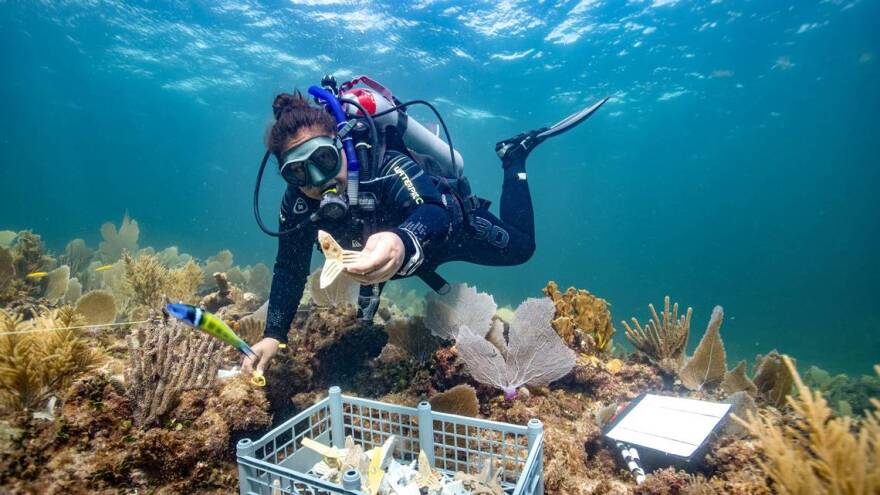Sandra Mendoza Quiroz knows how depressing news about coral reefs are – at least usually. Having worked to restore coral reefs in her native Mexico, she’s seen her efforts decimated over and over again. But last summer was different.
Amid a mass bleaching that ended up killing entire species of coral in the Caribbean and left much of the Florida Keys reef tract looking like coral graveyards, Mendoza Quiroz slipped into her wetsuit, adjusted her scuba gear and jumped into the warm, moonlit water off Mexico.
Diving with a handful of colleagues from Secore International, a non-profit working to save coral reefs she did indeed see the ghostly white grave sites she had prepared for mentally. But then there was more: A few juvenile coral had survived the death and destruction, and appeared to be thriving, Mendoza Quiroz told The Miami Herald.
“Extremely incredulous,” is how Secore’s Florida-based research director, Margaret Miller, described her initial reaction. When Mendoza Quiroz shared her discovery, Miller and other scientists were still in a prolonged state of shock over a bleaching epidemic that started in July 2023, a month sooner than the average, and the resulting mass die-off. The news of the fledgling survivors, however, snapped them straight into action.
READ MORE: Researchers are trying to save Florida's blighted corals by freezing their larvae
The first step was to confirm that the finding wasn’t just a fluke, but a pattern. Since the juveniles were born through an arduous “assisted reproduction” in which Secore’s scientists mix coral sperm and eggs in a lab and eventually plant baby coral in the reefs – a process not unlike in vitro fertilization, widely known as IVF – the group needed to check whether their other coral had survived, too. Over the next months, the scientists documented the health of juvenile coral of six species, all IVF-conceived, across five sites in the Caribbean Sea from Curacao to the U.S. Virgin Islands.
On Wednesday, their peer-reviewed study, published in the scientific journal PLOSONE, shows that there is reason for hope. Though juveniles are typically weaker than mature coral, the six species Secore helped produce survived the rising ocean temperatures that trigger bleaching when other coral didn’t.

The exact reasons will be the subject of further research — Miller suspects that more heat-resistent algae living in symbiosis with the juveniles might play a role — but the study offers hope for efforts to restore reefs that are essential to the marine food chain but also help buffer the coastline from worse effects of storms and flooding. Coral researchers “are all very encouraged by the findings,” Alex Neufeld, science program manager at the Coral Restoration Foundation, which is based in Key Largo, told the Miami Herald.
“It’s wonderful to see that the natural corals of the Caribbean still have the capacity to produce resilient offspring,” he said, adding that the study confirmed assisted sexual reproduction of coral as an additional tool to pre-existing methods, such as growing chunks cut off coral in nurseries, then returning them to the reef.
Millions of these nursery-grown coral have replenished natural reefs to date and they’ve been the primary method of restoration efforts in South Florida. But some also worry that these clones do not add the genetic diversity that could result in the more heat-resistant coral that’s necessary to continue protecting our coasts.
So scientists devised a new method that resembles the IVF that helps humans conceive.
Left to nature, coral’s mating prospects are somewhat restricted by their inability to walk, fly or swipe Tinder to find a mate. Reef-bound, the males and females eject their sperm and eggs into the water instead, hoping that they’ll find one another. Out of the few that do, only the luckiest of these free-floating, embryonic specks eventually end up swished against a reef or pre-existing coral, where they can grow and mature.
It’s this complex, caterpillar-to-butterfly metamorphosis that the scientists have given a boost. When the coral spawn, the researchers head out to the reefs and fill silvery, roughly waist-tall cones with water. Back when Mendoza Quiroz started out, water collected from a reef would yield hundreds of milliliters of sperm and eggs. Today, less than 15 years later, so many coral have died that the number has plummeted to less than 5 milliliters.
Still, it’s enough to grow at least some coral “that are surviving rather well…which is definitely good news,” Andrew Baker, who directs the University of Miami’s Coral Reef Futures Lab, said.
Baker’s own lab recently received coral sperm and eggs that traveled on a 15-hour flight from Honduras. Introducing Honduran coral genes to Florida could help local coral survive even warmer waters. “The question is, as we enter this new era of rapid climate change, how severe will these heatwaves get,” Baker said, “and how much can the corals, even the ones we reproduce, take?”
This story was produced in partnership with the Florida Climate Reporting Network, a multi-newsroom initiative formed to cover the impacts of climate change in the state.
Copyright 2024 WLRN Public Media




